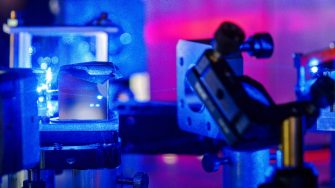
Photonics and Optoelectronics Laboratory
Project ID: 150
Supervisor(s): Peter Reece
In the Photonics and Optoelectronics Lab, we run a diverse range of experiments based on the development and application of advanced laser spectroscopy and microscopy techniques. Our current activities include: the study of ultra-fast carrier dynamics in semiconductors quantum heterostructures; imaging through multimode optical fibres; the fabrication and characterisation of novel optical metamaterials; optical trapping of nanoparticles; quantum sensing with nanodiamonds; and more. As well as doing basic research into Optical Physics, we collaborate with many other groups to apply our techniques to address interesting problems in other disciplines.
Below are listed a couple of topics that are currently under-investigation and could be:
Optically Trapped Nanodiamonds for Nanoscale Magnetic Resonance Sensing
Nitrogen-vacancy defect centres in diamond form the basis of a leading technology in quantum sensing that exhibit high sensitivity towards AC and DC magnetic fields as well as a host of different external stimuli, including electric field, strain, temperature, chemical environment, and more. Significant opportunities exist in combining nanodiamond (ND) based magnetic sensing with micromanipulation techniques, such as atomic force microscopy and optical tweezers. Specifically for optical trapping, ND based sensors can in principle be directed towards regions of interest within a complex fluidic environment and oriented, via optical torques, to probe different microscopic regions. In this project we explore novel methods for combining diamond-based quantum sensing with optical trapping for nanoscale magnetometry applications. Our work focuses on improving co-localisation of target objects with quantum sensors and also on implementing different measurement protocols for improved sensitivity. (Collaboration with D. A. Simpson at the University of Melbourne).
Optical trapping of resonantly scattering nanoparticles
Combining nanotechnology with optical trapping offers new possibilities for developing photonic force probes and nanoscale sensors with engineered functionality that target specific types of physical, biological and chemical interactions. In this study, you will explore the possibility of combining spectroscopic techniques with optical tweezers to interrogate the Brownian dynamics of trapped semiconductor and metallic nanoparticles that exhibit scattering resonances.
Rapid isolation and analysis of circulating exosomes using label-free nanoplasmonic sensors for non-invasive breast cancer diagnosis
Exosomes are membrane nano-sized vesicles secreted from mammalian cells that have been reported to play an important role in intercellular communication. Recently, exosomes have been shown as promising circulating biomarker for non-invasive cancers diagnosis. In this research, we aim to fabricate nanoplasmonic sensors based on nanohole arrays with optimized optical signature that can be used for rapid targeted detection of exosome in a microfluidic assay. (Joint project with Dr Ying Zhu (UNSW St George Clinical School)
Ultrafast spectroscopy of Group III-V quantum heterostructures
In this project, you will use a range for spectroscopic techniques to study the carrier dynamics and luminescence properties of novel compound semiconductor quantum heterostructures. The structures are used in a range of important technologies including, diode lasers, photovoltaics and photodetectors. (Joint project with S. Bremner, School of Photovoltaics and Renewable Energy Engineering)
Imaging through multimode optical fibres
Multi-mode fibres support hundreds of different electromagnetic waveguide modes, each with a distinct intensity profile and propagation constant. When coherent laser light is coupled to a fibre the interference between the modes will produce a complex speckle pattern at the fibre-output. Using adaptive optics it is possible to disentangle this speckle pattern so that the light again produces a uniform wavefront. With this knowledge, the fibre may be used as miniature endoscope to capture and images and videos. This project will develop the ideas of imaging through complex scattering media, such as tissue and other turbid media.
Nanostructured silicon based optical metamaterials
The ability to structure materials at the nanoscale enables the possibility of creating tailored artificial metamaterials that present extraordinary optical effects, such as invisibility, perfect imaging and generalised refraction. Access to these unusual properties provides new and exciting opportunities for applications in the field of optics and photonics.
Sub-diffusion and stochastic resonances effects in optical trapping
In this project, you will use optical tweezers to experimentally test different mathematical models that describe diffusive processes in spatially complex media. It will involve monitoring the stochastic motion of individual nanoparticles trapped in different types of static and time-varying potential energy landscapes. (Joint project with C. Angstmann and B. Henry, School of Maths)
For further information on any of these projects please contact: p.reece@unsw.edu.au
